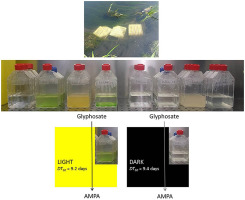Environmental Pollution ( IF 7.6 ) Pub Date : 2020-01-09 , DOI: 10.1016/j.envpol.2020.113951 Joan Artigas 1 , Isabelle Batisson 1 , Louis Carles 1

|
Environmental dissolved organic matter (DOM) has been proved to increase microbial population sizes and stimulate the degradation of some pesticide molecules. Among these molecules, the present study investigated the biodegradation of the herbicide glyphosate depending on photoautotrophs DOM supply in a microbial consortium isolated from river biofilms. Degradation experiments in the laboratory were performed in dark and light conditions, as well as after antibiotic supply, in order to characterize the eventual interactions between photoautotrophs and heterotrophs activity during glyphosate degradation. Fifty percent of the initial concentration of glyphosate (0.6 mM) was transformed into aminomethyl phosphonic acid (AMPA) after 9 days in presence or absence of light. Accordingly, the photoautotrophic DOM supply was not stimulating glyphosate degradation by microbial heterotrophs. This lack of response was probably explained by the low net primary production values and weak dissolved organic carbon production recorded in light treatments. The supply of the antibiotic drastically stopped glyphosate transformation demonstrating the central role of bacteria in the biodegradation of the herbicide. Glyphosate also modified the structure of prokaryotes assemblages in the consortium by increasing the relative abundances of Alphaproteobacteria and slightly decreasing those of Gammaproteobacteria. The chemoorganotrophic bacteria Phenylobacterium sp. (Alphaproteobacteria) was related to the transformation of glyphosate in our microbial consortium. The present study highlights the complexity of microbial interactions between photoautotrophs and heterotrophs in microbial assemblages that can contribute to the degradation of pesticides present in aquatic environments.
中文翻译:

溶解的有机物不会促进自异养水生微生物群落中的草甘膦降解。
环境溶解有机物 (DOM) 已被证明会增加微生物种群规模并刺激某些农药分子的降解。在这些分子中,本研究调查了除草剂草甘膦的生物降解取决于从河流生物膜中分离出的微生物群落中光合自养生物 DOM 的供应。实验室的降解实验在黑暗和光照条件下以及抗生素供应后进行,以表征草甘膦降解过程中光合自养生物和异养生物活性之间的最终相互作用。在有光或无光的情况下 9 天后,草甘膦初始浓度 (0.6 mM) 的 50% 转化为氨甲基膦酸 (AMPA)。因此,光合自养 DOM 供应不会刺激微生物异养生物降解草甘膦。这种缺乏反应的原因可能是光处理中记录的净初级生产值较低和溶解有机碳产量较弱。抗生素的供应彻底阻止了草甘膦的转化,这证明了细菌在除草剂生物降解中的核心作用。草甘膦还通过增加 Alphaproteobacteria 的相对丰度并略微降低 Gammaproteobacteria 的相对丰度来改变该群落中原核生物组合的结构。化学有机营养细菌苯杆菌属。 (Alphaproteobacteria)与我们微生物群落中草甘膦的转化有关。本研究强调了微生物组合中光合自养生物和异养生物之间微生物相互作用的复杂性,这可能有助于水生环境中存在的农药的降解。











































 京公网安备 11010802027423号
京公网安备 11010802027423号